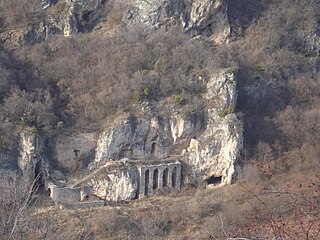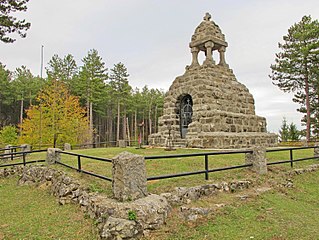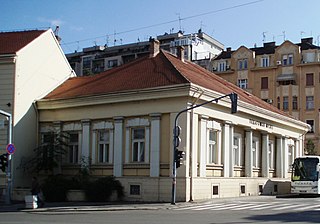
Dušan Džamonja was a Yugoslav, Croatian and Serbian sculptor of Serbian ancestry.

Ilija M. Kolarac Endowment, also known as the Kolarac People's University Building, is at 5 Students' Square in the heart of Belgrade. The building is a monument of a great cultural and historical importance and as such was declared as the immovable cultural property.

White Bridge or Bridge of love, is a bridge in Vranje, over the Vranje river, in southeastern Serbia. It is in the old quarters of the city, in the Devet Jugovića Street. It was constructed with white stone and dates from 1844, during the Ottoman administration, and is one of the main symbols of Vranje. The bridge is also featured on the city coat of arms.

The Hermitage and Monastery of Saint Peter Koriški is a ruin of the hermitage and monastery located in Koriša, Prizren municipality, Kosovo. The monastery and hermitage are on the same location.
Kaljaja is an archaeological site, which is located in Teneš Do on the hill Kaljaja in Kosovo.

Monastery of the Mother of God in Hvosno was a Christian monastery of the Serbian Orthodox Church in the historical region of Hvosno. It was situated at the foot of Mokra Mountain, nearby hamlets Vrelo and Studenica, some 20 kilometers north of the city of Peć, in modern Kosovo. The Monastery was declared Monument of Culture of Exceptional Importance on 10 July 1967, and Republic of Serbia claims to have it under protection.

Memorial Ossuary Mačkov kamen is a memorial monument located near Krupanj, Serbia, which stands on the mountain Jagodnja at an elevation of 923 m. The remains of fallen soldiers from the First World War are stored inside.

Memorial Ossuary Cer was built in the village Tekeriš on the mountain Cer. The remains of the killed Serbian soldiers after the Battle of Cer in World War I were buried there. Memorial ossuary Cer is on the list of Immovable Cultural Heritage of Exceptional Importance.

Vukdrag was a Serbian nobleman who served King Stefan Dečanski as čelnik. He was a magnate in the Rudnik mountain area, who founded the Raška style church in Dići, below the Rudnik, before 1327, most likely as a family temple. He must have had one of the important gubernatorial functions in the Rudnik oblast (province) during the reigns of kings Stefan Milutin and Stefan Dečanski. Unknown in historical sources, he was buried in his church, where his gravestone inscription tells that he died on 8 May 1327, on the Feast of the Ascension (Spasovdan), and that he had taken monastic vows as Nikola (Никола) and [once] held the title of čelnik. It is unclear if there was one or several individuals with that title at the court at that time; Đuraš Ilijić was mentioned with the title in 1326, and Gradislav Vojšić, for the second time, in 1327. He was buried in a special tomb inside the church, and his gravestone was set by his wife Vladislava. The unearthing of the gravestone gave new facts in the understanding of the territorial contours of the Serbian state north of Rudnik at the end of the 13th- and beginning of 14th century. The largest medieval necropolis in Serbia was unearthed around the church, with flat gravestones belonging to the oldest phase of the Stećak culture.

„Cvijeta Zuzorić“ Art Pavilion is an exhibition building in Belgrade, in Kalemegdan, situated in the park's section of Little Kalemegdan, next to the south-eastern front of the Belgrade fortress. It was built between 1927 and 1928 after the design of the architect Branislav Kojić, in the Art Deco architectural style. It was the first venue built specifically as an exhibition space, or an art gallery, in Serbia.

The Officers' Club in Belgrade, is situated at 48 Kralja Milana Street and as the memorial of the development of Belgrade at the end of the 19th century it has the status of a cultural monument.

Vozarev Cross is located in Belgrade, in the park between Vojvode Šupljikca Street and Mileševska Street, and it was erected in 1847. It represents the immovable cultural property as the cultural monument. The famous Belgrade bookseller and a printer, Gligorije Vozarević, erected a wooden cross decorated with icons in his own field at Vračar. The contemporaries interpreted the erection of the cross not only as the symbol of the faith and religion, but also as the symbol of the liberation – the symbol of the victory. For that reason, this cross is considered as the first public monument in Belgrade. The ruined wooden cross was replaced by the Belgrade Municipality in 1933 with one in red artificial stone. The part of Belgrade was named after it Crveni Krst.

Monument to the Liberators of Belgrade in Karađorđe's park is an authentic historical place of the camp of the main insurgent army and of the military cemetery of the liberators of Belgrade under Karađorđe during the Siege of Belgrade in 1806. The monument in the cemetery was erected by Prince Aleksandar Karađorđević in 1848. It is the first monument in Belgrade erected in the honour of a historical event, and at the same time the first public monument.

The Rančić family house is located in Grocka, at 9 Majevička Street, in the immediate vicinity of the Čaršija in Grocka, on the elevated spacious plot, set free in relation with the street regulation. The House was built in the beginning of the House, as the two-part Kosovo style ground-floor house, built in half-timbered construction filled with wattle and daub, and covered with four-sided ceramide roof with large roof drains – eaves. Along the entire front facade there was a very deep architraved porch levelled with the terrain. There was a special door leading from the porch into the „house“, that is, the room, while the internal communication between the „house“ and the room was left out. The rooms in the house were separated, not mutually connected, so later on, the house was rebuilt. It was elevated then so that it got a basement and a veranda, which gave it the appearance of the town house. The present organization of the rooms was done around the heart room, as the central room directly connected to the porch.

The Realka High School Building is at the corner of 14 Uzun Mirkova Street and Tadeuša Košćuška Street, built between 1835 and 1840 in the style of classicism, most probably after the design of Franc Janke. Its social and historical value lies in the importance it had as the school building which attended and in which taught many important persons of 19th-century Serbia: the teachers Stevan Todorović, Todor Mijušković, Petar Ubavkić, Mihajlo Valtrović, Đorđe Krstić, and students Kosta Glavinić, Milan Kapetanović, Svetozar Jovanović, Milorad Ruvidić, Danilo Vladisavljević, Nikola Nestorović...The building was named after the Belgrade Realka, located within it for a long time. The oldest preserved building in Belgrade was built in European style and is a unique example of classicism.

The Ministry of Finance of Serbia Building is a building of the Ministry of Finance of Serbia, located in Savski Venac, Belgrade, Serbia.

Jovan Cvijić's house is situated in Belgrade, in 5 Jelena Ćetković Street. The house was built in 1905, on the site of the former garden of Мitropolit Mihailo of Belgrade, which in 1907 was transformed into the square. A couple of years later, more precisely in 1924, the square was named Коpitareva gradina, after the famous Slavist and linguist, Јеrnej Kopitar. Many important figures of that time used to build their houses in this area: a sculptor Petar Pavličanin, a doctor and a writer Laza Lazarević, an architect Milan Antonović.

Pavlović`s family house family is situated in Belgrade, at 39 Gospodar Jevremova Street, and it has the status of the cultural monument. The house was built in 1882as a ground-floor family house of Kosta St. Pavlović, then head of the department of the Ministry of Foreign Affairs and the former mayor of Niš after the liberation from Ottoman rule. Before the very building of the house, Kosta Pavlović along with the professor Ljuba Kovačević and the general Јovan Mišković bought the lots in a row, on the bank of the Danube. Up to now, there are „testimonies“ of the mayor Ž.M.Blaznavac about the purchase of the lots.

Krsmanović's House, situated at 34 Terazije Street in Belgrade, was built in 1885 for a merchant. In 1918, it became the house of Alexander Karađorđević, Prince Regent of Yugoslavia and was used as a theatre before it became public property after World War II. It has served as the Protocol building of the Ministry of Foreign Affairs. The Academic art house is considered among the best designs of the architect Jovan Ilkić.

Belgrade Town Hall building is located at 1 Uzun Mirkova Street, in Belgrade, and has the status of the cultural monument. It was built around 1846, during the reign of Prince Aleksandar Karađorđević, and is located on the site of the former Great bazaar. In the second half of the 19th century, the area around the Great Bazaar was the venue of the administrative and educational life of the capital. The hotel worked until 1869, when the name "Serbian Crown" was overtaken by the restaurant at 56 Knez Mihailova Street. During the period of almost one century, the building at the Great Bazaar served the needs of Belgrade municipality. The building was constructed as two-storey object with classically shaped front facade, whose symmetry was achieved with the shallow central Avant-corps with attic above the cornice. The reconstructions and the addition of the floor from 1928 significantly changed the appearance of the building. Today`s facade is dominated by the monumental fluted semi-columns in the ground floor zone, and lunette windows. Nowadays, Yugoslav Film Archive is placed in the building.




















